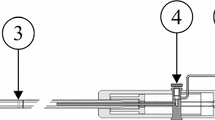Abstract
The International Temperature Scale of 1990 (ITS-90) is commonly expressed in terms of the ratio of the resistance of a standard platinum resistance thermometer (SPRT) to the resistance at the triple point of water. Most high-precision thermometry relies on the alternating current (AC) method due to its manifold practical benefits. However, there are some negative consequences of using AC methods, and it is of particular interest to quantify the effect of the measuring current frequency on the realized temperature of the ITS-90 fixed points. In this work, the effect of the measuring current frequency was investigated by measuring the differences between the AC and direct current (DC) resistance ratios at various fixed-point temperatures. Two AC at 30 Hz and 90 Hz and one DC at a reversal frequency of 3 Hz were used to measure the resistance ratios at four ITS-90 metal fixed points, namely, mercury, water, zinc, and silver; seven SPRTs having different nominal resistances (e.g., 0.25 Ω, 0.6 Ω, 2.5 Ω, and 25 Ω) were employed to explore the effect of frequency on the measured resistance ratio. It was found that the frequency dependence was most noticeable at the freezing point of silver where the insulation leakage and its transient dielectric polarization were expected to manifest themselves the most significantly. For other fixed points, the frequency dependence was found to be insignificant, implying that under normal conditions the benefits of the AC measurements can be fully utilized without affecting the calibration uncertainties of the tested types of SPRTs.











Similar content being viewed by others
Data Availability
All the raw data are available (if requested).
Abbreviations
- I :
-
Magnitude of the measuring current
- G :
-
Gain
- R :
-
Resistance
- t :
-
Temperature
- U :
-
Expanded uncertainty
- V :
-
Voltage
- W :
-
Resistance ratio with respect to the resistance at the triple point of water (Rt/RTPW)
- X :
-
Resistance ratio with respect to the resistance of the reference resistor (Rt/Rref
- 1:
-
Operating condition for resistance ratio measurements
- 2:
-
Similarity condition for nonlinearity measurements
- T :
-
Temperature to be measured
- TPW:
-
Triple point of water
References
H. Preston-Thomas, Metrologia 27, 3 (1990). https://doi.org/10.1088/0026-1394/27/1/002
D.R. White et al., Uncertainties in the Realisation of the SPRT Subranges of the ITS-90, Working Document of the Consultative Committee on Thermometry CCT/08-19/Rev (BIPM, Paris, 2009).
Consultative Committee for Thermometry Under the Auspices of the International Committee for Weights and Measures, Guide to the Realisation of the ITS-90; Platinum Resistance Thermometry: Resistance Measurement (Paris, BIPM, 2018) https://www.bipm.org/en/committees/cc/cct/guide-its90.html
F.J. Wilkins, M.J. Swan, Proc. Inst. Electr. Eng. 117, 841 (1970). https://doi.org/10.1049/piee.1970.0168
K. Yamazawa, K. Harada, M. Arai, in Proceedings of the 41st SICE Annual Conference 2469 (Osaka, Japan, 2002) https://doi.org/10.1109/SICE.2002.1195795
J.V. Widiatmo, K. Harada, K. Yamazawa, J. Tamba, M. Arai, Int. J. Thermophys. 36, 2002 (2015). https://doi.org/10.1007/s10765-015-1847-x
C.G.M. Kirby, M.J. Laubitz, Metrologia 9, 103 (1973). https://doi.org/10.1088/0026-1394/9/3/001
K. Yamazawa, M. Arai, Temp. Meas. Control Sci. Ind. 7, 363 (2003). https://doi.org/10.1063/1.1627152
K. Yamazawa, M. Arai, in Proceedings of TEMPMEKO 2004, 409 (Cavtat-Dubrovnik, Croatia, 2004)
N.P. Moiseeva, in Proceedings of TEMPMEKO 2004, 433 (Cavtat-Dubrovnik, Croatia, 2004)
D.R. White, M. Arai, A. Bittar, K. Yamazawa, Int. J. Thermophys. 28, 1843 (2007). https://doi.org/10.1007/s10765-007-0276-x
K. Yamazawa, M. Arai, D.R. White, Int. J. Thermophys. 28, 1855 (2007). https://doi.org/10.1007/s10765-007-0273-0
J.P. Evans, J. Res. Natl. Inst. Stand. Technol. 89, 384 (1984). https://doi.org/10.6028/JRES.089.020
R.J. Berry, Metrologia 32, 11 (1995). https://doi.org/10.1088/0026-1394/32/1/002
J.V. Widiatmo, K. Harada, K. Yamazawa, J. Tamba, M. Arai, Temp. Meas. Control Sci. Ind. 8, 271 (2013). https://doi.org/10.1007/s10765-015-1847-x
J. Zhang, R.J. Berry, Metrologia 21, 207 (1985). https://doi.org/10.1088/0026-1394/21/4/006
C. Garcia, D. del Campo, F. Raso, Int. J. Thermophys. 32, 1399 (2011). https://doi.org/10.1007/s10765-011-0949-3
P. Marcarino, R. Dematteis, M. Arai, Humidity Effects in Long Stem SPRTs Working Document of the Consultative Committee on Thermometry CCT/96-7 (BIPM, Paris, 1996).
P. Marcarino, P.P.M. Steur, R. Dematteis, in Proceedings of TEMPMEKO `99, 80 (Delft, Netherlands, 1999)
W. Joung, K. Gam, I. Yan, Y. Kim, Temp. Meas. Control Sci. Ind. 8, 404 (2013). https://doi.org/10.1063/1.4819574
J.V. Pearce, J. Gray, R.I. Veltcheva, Int. J. Thermophys. 37, 109 (2016). https://doi.org/10.1007/s10765-016-2113-6
D.R. White, in Proceedings of TEMPMEKO `96, 129 (Torino, Italy, 1997)
R.J. Berry, Metrologia 2, 80 (1966). https://doi.org/10.1088/0026-1394/2/2/003
Acknowledgements
The authors thank Paul Bramley (Metrosol Limited) for suggesting a method of assessing nonlinearities of resistance bridges operating at different reference resistances and carrier currents than 100 Ω and 1 mA, respectively. The authors gratefully acknowledge constructive criticism from the anonymous reviewers, which improved the manuscript immeasurably. This work was supported by the Pukyong National University Research Fund in 2019 (C-D-2019-1534).
Funding
This work was supported by the Pukyong National University Research Fund in 2019 (C-D-2019-1534).
Author information
Authors and Affiliations
Corresponding author
Ethics declarations
Conflict of interest
The authors declare that they have no known competing financial interests or personal relationships that could have appeared to influence the work reported in this paper.
Additional information
Publisher's Note
Springer Nature remains neutral with regard to jurisdictional claims in published maps and institutional affiliations.
Rights and permissions
About this article
Cite this article
Joung, W., Lee, H. & Pearce, J.V. Effect of Resistance Bridge Current Frequency on Metal Fixed-Point Temperature Measurements. Int J Thermophys 42, 112 (2021). https://doi.org/10.1007/s10765-021-02863-4
Received:
Accepted:
Published:
DOI: https://doi.org/10.1007/s10765-021-02863-4




